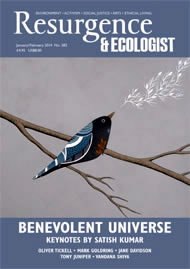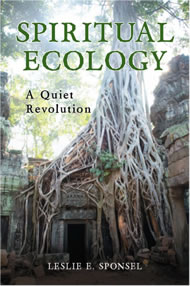Nature speaks to us, her children, with a voice that is at one and the same time stark and mysterious – stark in showing us how we are wounding her; mysterious in that what she says comes to us from a divine realm. Knowing more of this realm, which is often hidden, is utterly necessary if we are to survive in a world of increasing climatic disruption and resource depletion, because the way of being that will enable us to transform and make the transition can only arise there. How can we find our way to this realm, and how can we dwell therein? There are no more important questions than these for us to answer.
It may take a lifetime to discover this realm, or it may happen in a moment, today, but given its urgency it is helpful to find signposts. Leslie E. Sponsel’s Spiritual Ecology is a handbook to help us. Using the metaphor of a tree, with roots, a trunk, branches, leaves and flowers, seeds and fruits, this text traces the growth of the spiritual vision related to ecology, from early beginnings to the present time. The chosen sources are inevitably selective, but many – although not necessarily all – will be known to readers of Resurgence & Ecologist. There are great figures such as the Buddha and St Francis of Assisi, well-known writers such as Thoreau, Muir and Steiner, philosophers and activists such as Martin Buber, Joanna Macy and Wangari Maathai, and many others – 144 in all, including the editor of Resurgence & Ecologist, Satish Kumar.
The book provides a history of thought and lots of specific references to texts, organisations and projects, which “outline an intellectual history of the quiet revolution that is identified here as spiritual ecology” as well as identifying associated practical actions. And the examples chosen are deliberately drawn from a wide range of traditions, the goal being “to understand and appreciate different religions and spiritualities as they relate to environments, ecologies, and environmentalisms, and not to judge which ones…are more valid, useful, or better, but only to learn from the enduring wisdom of humanity as revealed in its religions and spiritualities”.
A useful guide, yes, but to what extent does the text describe ‘a quiet revolution’? It may do, but the substance and meaning of this is not entirely made clear – which is fine, since we each have to make the quest. Nevertheless, although this is often solitary and lonely, it helps to be in company sometimes; and it is here that the great traditions and sages give such support and even comfort.
The last section of the book suggests some of the ‘hazards’, political, economic and philosophical – not least the rise of the secular and the material in our lives. This is given only a small part, and rightly so. For to concentrate on opposition is to be held in the camp of the enemy; far better to propose than to oppose.
There is an evident need for a clear and strong expression of divine compassion as the informing principle of our relationship with Nature, with all that is, and in all that we do. It has always been so. And now we know it is timely and urgent. Hearing Nature’s cry and, within this, the cry of our human family, what shall we do?








